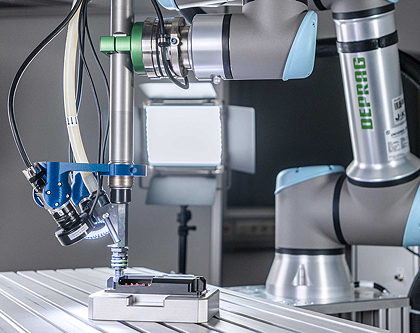- Home » News » Technology News
AI system automates previously impossible screwdriving tasks

The German screwdriving technology specialist Deprag has joined forces with the Berlin robotics software developer Micropsi Industries to develop what they claim is the first automated screwdriving system that can handle changes in the environment. They say that such automation has not been possible, or economically feasible, using previous technologies.
The companies add that the technology can also handle dynamic tasks on moving belts for the first time. It can be used to assemble a wide variety of products and components – including domestic appliances, automotive parts, agricultural machines and others. It can be set up and deployed in less than a day.
Screw assembly – creating secure connections between two or more parts, using one or more screws – sounds simple, but is extremely complex in practice due to variances such as position, angle and manufacturing tolerances. Using conventional automation to achieve this is complicated and expensive.
Variations that can arise in screwdriving operations include:
• Variance in the position of parts This makes the precise location of screw holes unpredictable, and is a particular problem when parts cannot be fixed in a workpiece carrier. Even if parts are in a carrier, they can still vary in position by several millimetres.
• Variations in screw insertion angles According to Micropsi and Deprag, it is almost impossible for traditional automation systems, which need uniform conditions, to overcome the complexity that results from unpredictable screw-hole locations, or unaligned holes. As a result, many screwdriving assembly tasks have to be done by hand. The same applies to nuts, studs and flow-form screws.
The new approach combines Deprag’s screwdriving technology with Micropsi’s Mirai robot control system. Using AI (artificial intelligence), Mirai-controlled robots can handle complex tasks which were previously impossible, extremely complicated or unprofitable to automate.
Mirai attaches to a robot. Once fitted, it allows the robot to perceive its environment and correct its movements in real time as it performs a task. It can be trained or retrained easily and quickly by people with no background in engineering or AI.

To demonstrate their new approach, Micropsi and Deprag performed tests on an application involving four screws driven into an electronic module to join a top piece with a base. The Mirai and Deprag technologies were attached to a Universal Robots UR16e cobot (collaborative robot).
The task was broken down into four parts:
• First, the robot positions a screw (fed to the screwdriver by a Deprag feeding system) about 50-60mm from a screw-hole. At this position, the robot’s controller hands over to the Mirai system.
• Mirai assumes control of the robot, positioning the screw tip just above the threaded hole.
• The screwdriving system then takes command, inserting and securing the screw to a specific torque or angle. At the same time, the screwdriver is fed another screw.
• Guided by its own controller, the robot pulls back and approaches the next hole.
With this set-up, the system was able to handle variations in the position of the electronic module in the workstation, as well as in the angle at which it inserts the screws into the holes.
Micropsi Industries, founded in 2014, has locations in Berlin (where it performs r&d) and San Francisco. It focuses on robotic assembly tasks.
Deprag Schulz supplies screwdriving and feeding technologies, automation systems, air motors and tools, as well as energy recovery products. It has 760 employees in more than 50 countries.
Micropsi Industries: Twitter LinkedIn Facebook
Deprag: Twitter LinkedIn Facebook





